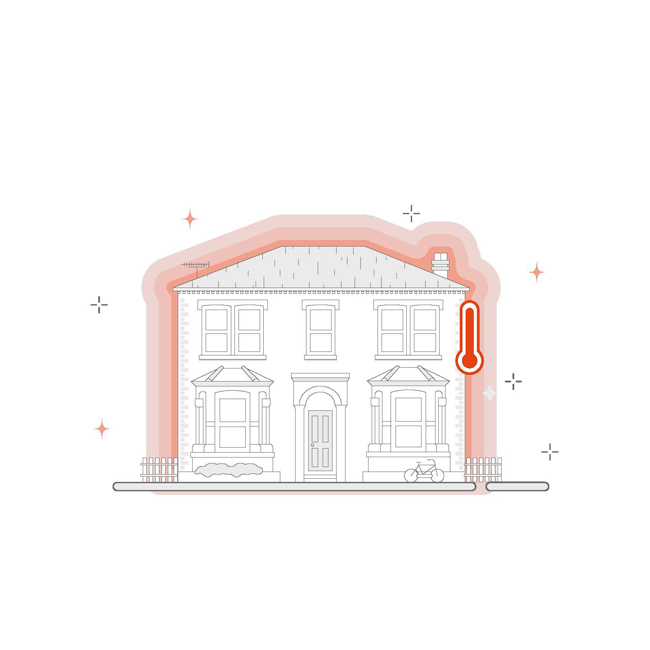Best ways to insulate your home
Tired of layering up in the house? Fed up with cold feet? Uncomfortable in your own home? We hear you loud and clear. Read on to uncover the best ways to cut out the draughts and warm up your home.
Insulating your home has many benefits: it increases the value of your property, helps you save on gas and electricity bills, reduces your carbon footprint, improves your health and makes for a more comfortable and happy home.
There are so many methods of insulation for properties, how can you possibly know which one to choose? The key is to find the one or ones that best suit you and your home in terms of cost, level of disruption, and, most importantly, comfort.
A combination of several insulation methods might be the right option for your home. After all, when you wrap up warm in winter, you don’t walk around barefoot because you’re already wearing gloves. In the same way, your home may need a package deal to ensure the draughts and cold are left at the door.
We’ve done the grunt work for you and laid out some of your best home insulation options below, starting with the most efficient ones.
 |
Contact us for a free consultation
Install floor insulation
The most cost-effective option for properties with suspended floors is underfloor insulation, which reduces draughts and ensures an instantly warmer home.
Q-Bot’s innovative insulation-spraying robot can insulate your home in as little as a day with the minimum of disruption. There are other options for underfloor insulation, but they aren’t as straightforward, or cost effective. If you are interested in finding out more about floor insulation options, you can check out The Best Ways to Insulate Your Floor.
Insulate your loft
We all know that heat rises, which is why it makes sense to save heat from escaping through your roof by insulating your loft, like a hat for your home. This requires fitting insulation material on the floor of your loft, which blocks heat from rising up any further. Loft insulation is a very cost-effective method of insulation, cutting energy bills and warming up your home, that’s why most properties in the UK already have it.
Install cavity wall insulation
Cavity wall insulation requires filling the hollow space (cavity) between the inner and outer wall of a property with insulation material, usually glass fibre wool or polyurethane foam. While this method is effective and non-disruptive, it does not apply to homes that have solid walls. If your walls are hollow, chances are that they have already been insulated, as about 70% of cavity walls in the UK have already been filled. If your walls have not been insulated, you can hire a professional to do this. Costs depend on the size of your home, but this is generally a cost-effective way of efficiently insulating your home.
Internal wall insulation
Internal wall insulation is just as labour-intensive as external wall insulation and is a relatively disruptive option, which requires rewiring, moving radiators and re-decorating every room. However, it is a very effective, long-term solution – especially if you are considering a significant home refurbishment. To insulate your internal walls, an inner wall of insulation is added to the inside of your external walls. A gap is left in between the insulation material and the wall so as to avoid damp and mould. Your home will be much warmer, but you will lose a bit of floor space.
External wall insulation
If your home has solid walls, you can choose to insulate them through internal or external wall insulation. Insulating your wall externally involves fixing a layer of insulation to the outside of your home and then covering it with render or cladding. It is an effective, but relatively labour-intensive and an expensive solution to insulating your home and can have planning and aesthetic implications.
Double glazing
Homes with single glazing windows or windows with gaps or cracks can result in heat loss and can let draughts in. Although there are a few DIY options to try to seal the gaps around your windows, another option is to replace your single glazing windows with double glazing. Fitting your windows with double glazing is a very expensive but effective method of warming your home, and some government grants and funding may be available in some instances.
Draught-proof your home
A quick-win and cheap DIY option for your home. Draught-proofing involves closing unwanted gaps and openings in your property. It is not the most airtight solution, but it can be a quick-fix to improve comfort and reduce cold draughts. If your home doesn’t already have some sort of draught-proofing, it may be worth giving it a go, especially if you are only experiencing mild discomfort. Some draught-proofing options include: filling gaps between windows and frames with foam, metal or plastic strips; installing thermal or heat curtains around your home; covering your keyhole, letterbox and the gap at the bottom of your doors; and filling gaps around pipework and cracks in walls.
These are the most common methods of insulating your home, and you may need to call on more than one to create your perfect, cosy home. Unfortunately, there is no “one size fits all” for insulating your home. A qualified Retrofit Coordinator can help you to decide which options and methods will suit you best. It all depends on how your home is built, and what is right for you and your family.
